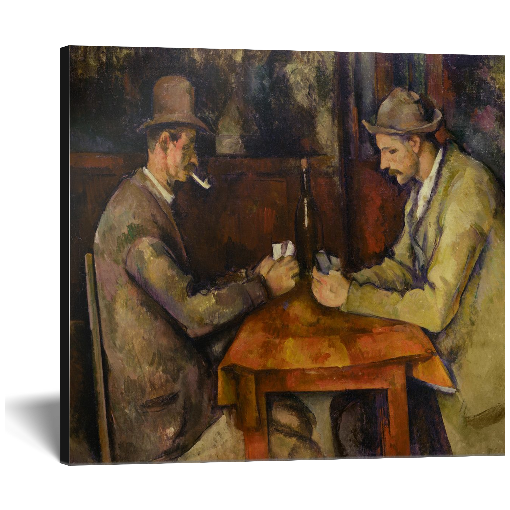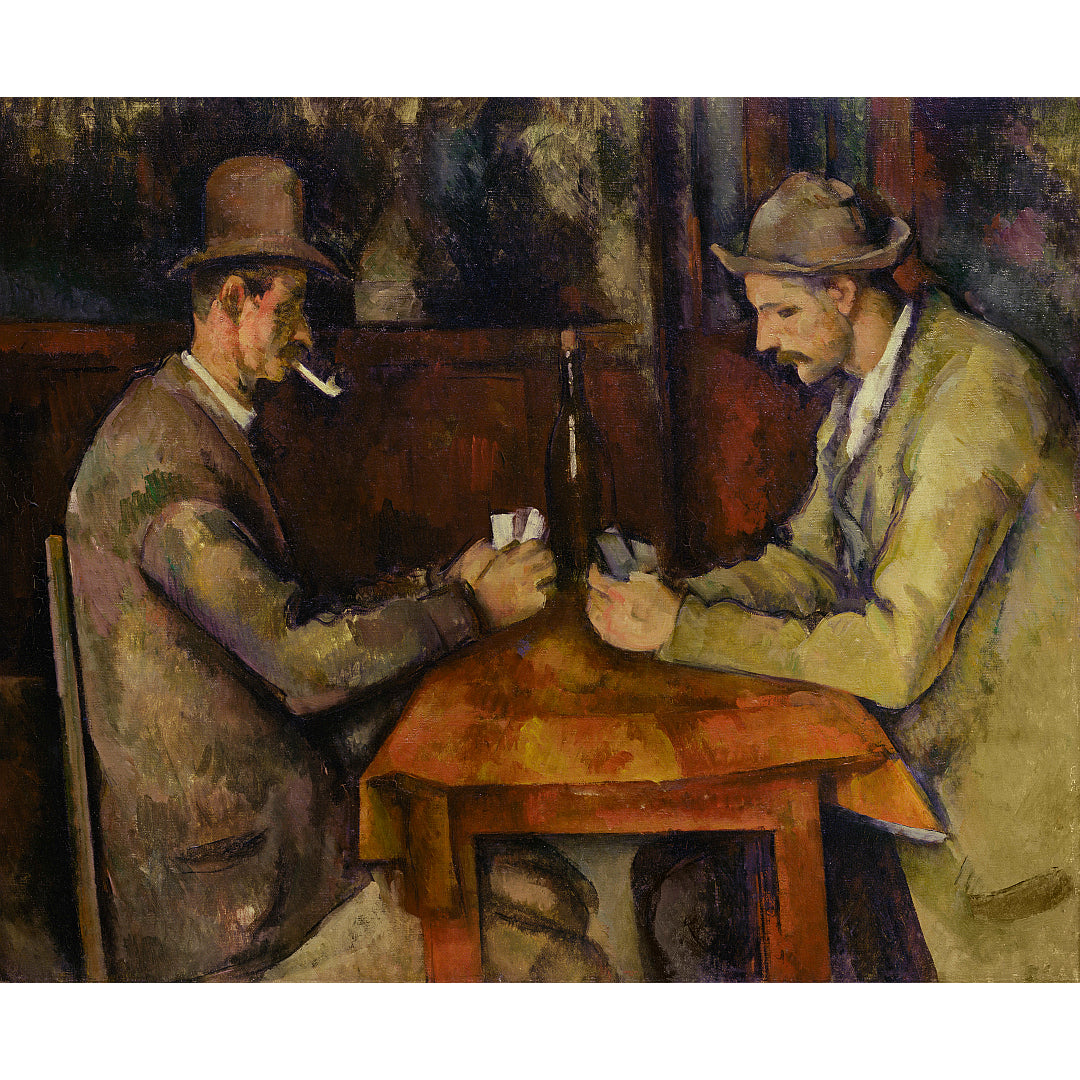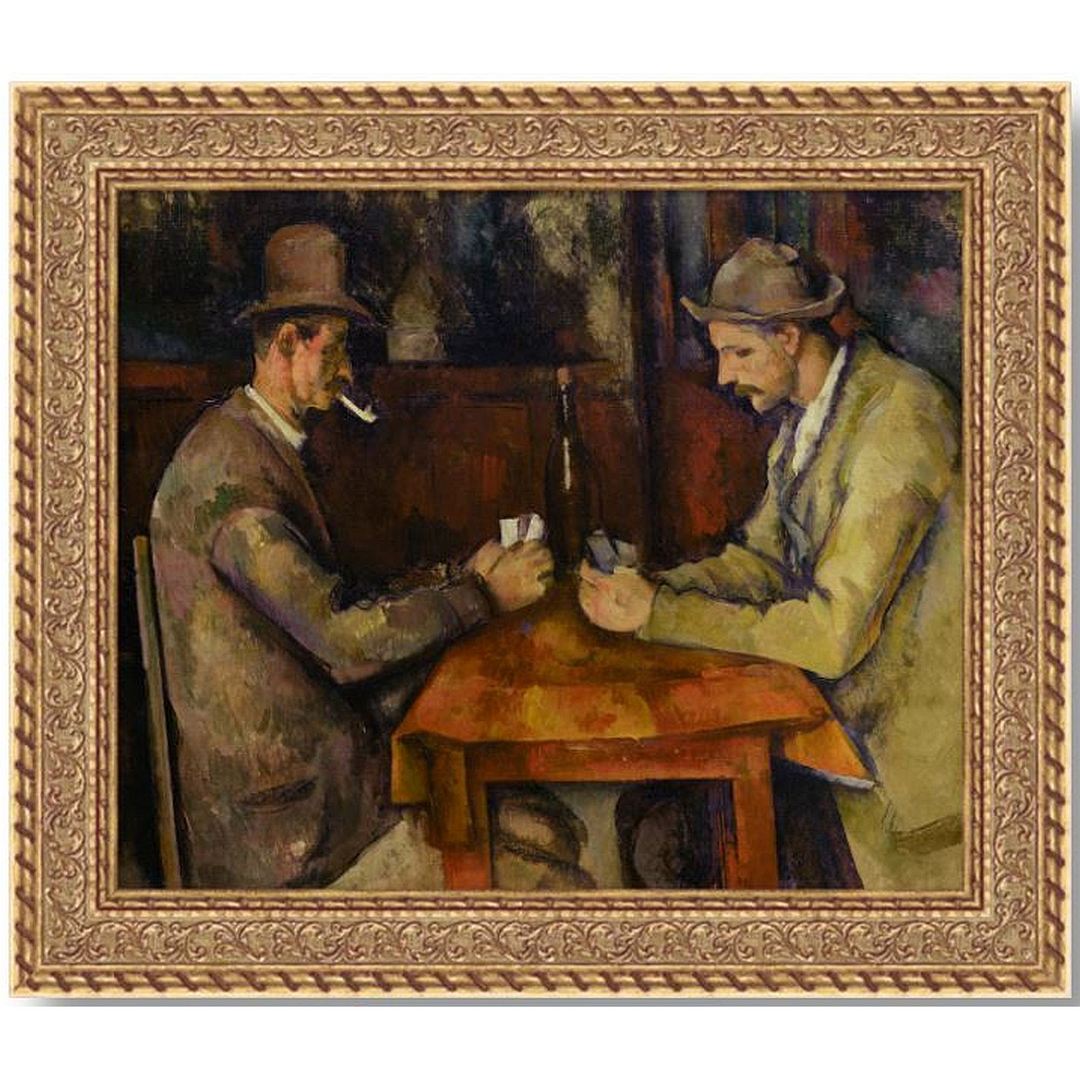The Card Players - Paul Cézanne (c. 1890-5)
The Card Players - Paul Cézanne (c. 1890-5)
Couldn't load pickup availability
Made in USA
Options:
1) Stretched Mounted 3/4" Thick.
2) Chateau Florentine Gold 2 1/4" Gold Leaf Gilded Wood Frame by Larson-Juhl.
18" x 15" Artwork on Scratch-Resistant True-Matte Archival Canvas. Our true-matte canvas is a well-textured 19 mil bright white, consistent poly-cotton blend with a real matte look and feel. Utilizing newer giclée technology, this is one of the first scratch-resistant matte canvases available. With an eye-popping color gamut and dmax, coupled with critical archival certification and the ability to apply a laminate hassle-free, it sets a new standard of exceptionalism in fine art. Internally, we refer to this masterful blend of artistry and engineering as "the game changer" that will capture every nuance in your images.
----------------------------------------
The Card Players is a series of five oil paintings by the French Post-Impressionist artist Paul Cézanne. Painted in the early-to-mid 1890s, they are considered to be a "prelude" to his final years when he painted some of his most acclaimed work. The paintings vary in size, the number of players, and the setting in which the game takes place.
One version of The Card Players was sold in 2011 to the Royal Family of Qatar for a price estimated at $250 million ($350.8 million today), signifying a new mark for highest ever price for a painting. This was not surpassed until the sale of the Leonardo da Vinci painting, Salvator Mundi, in November 2017.
Each painting depicts Provençal peasants immersed in their pipes and playing cards. The subjects, all male, are displayed as studious within their card playing, eyes cast downward, intent on the game at hand. The models for the paintings were local farmhands, some of whom worked on the Cézanne family estate, the Jas de Bouffan. Each scene is depicted as one of quiet, still concentration; the men look down at their cards rather than at each other, with the cards being perhaps their sole means of communication outside of work. One critic described the scenes as "human still life", while another speculated that the men's intense focus on their game mirrors that of the painter's absorption in his art.
Cézanne adapted a motif from 17th-century Dutch and French genre painting which often depicted card games with rowdy, drunken gamblers in taverns, replacing them instead with stone-faced tradesmen in a more simplified setting. Whereas previous paintings of the genre had illustrated heightened moments of drama, Cézanne's portraits have been noted for their lack of drama, narrative, and conventional characterization. Other than an unused wine bottle in the two-player versions, there is an absence of drink and money, which were prominent fixtures of the 17th-century genre. A painting by one of the Le Nain brothers, hung in an Aix-en-Provence museum near the artist's home, depicts card players and is widely cited as an inspiration for the works by Cézanne.
The largest version, painted between the years 1890–1892, is the most complex, with five figures on a 134.6 x 180.3 cm (53 × 71 in) canvas. It features three card players at the forefront, seated in a semi-circle at a table, with two spectators behind. On the right side of the painting, seated behind the second man and to the right of the third, is a boy, eyes cast downward, also a fixed spectator of the game. Further back, on the left side between the first and second player is a man standing, back to the wall, smoking a pipe and presumably awaiting his turn at the table. It has been speculated Cézanne added the standing man to provide depth to the painting, as well as to draw the eye to the upper portion of the canvas. As with the other versions, it displays a suppressed storytelling of peasant men in loose-fitting garments with natural poses focused entirely on their game. Writer Nicholas Wadley described a "tension in opposites", in which elements such as shifts of color, light and shadow, shape of hat, and crease of cloth create a story of confrontation through opposition. Others have described an "alienation" displayed in the series to be most pronounced in this version. The painting is owned and displayed by the Barnes Foundation museum in Philadelphia, Pennsylvania.
A more condensed version of this painting with four figures, long thought to be the second version of The Card Players, is in the Metropolitan Museum of Art in New York. At 65.4 x 81.9 cm (25 3/4 x 32 1/4 in), it is less than half the size of the Barnes painting. Here the composition remains virtually the same, minus the boy, with viewers' perspective slightly closer to the game, but with less space between the figures. In the previous painting, the center player as well as the boy were hatless, whereas this version has all the men hatted. Also gone are the shelf to the left with vase and lower half of a picture frame in the center of the wall, leaving only the four pipes and hanging cloth to join the smoking man behind the card players. The painting is brighter, with less focus on blue tones, than the larger version. X-ray and infrared studies of this version of The Card Players have shown layers of "speculative" graphite underdrawing, as well as heavy layers of worked oil paint, possibly suggesting it was the preliminary of Cézanne's two largest versions of the series, rather than the second version as historically believed. The underdrawing has also led analysts to believe Cézanne had difficulty transferring the men, previously painted individually in studies, onto one canvas.
It has been speculated that Cézanne solved this "spatial conundrum" in the final three versions of The Card Players, by eliminating spectators and other "unnecessary detail" while displaying only the "absolute essentials": two players immersed in their game. The scene has been described as balanced but asymmetrical, as well as naturally symmetrical with the two players being each other's "partner in an agreed opposition". The man on the left is smoking a pipe, wearing a tophat with a downcast brim, in darker, more formal clothing, seated upright; the man to the right is pipeless, in a shorter hat with upcast brim, lighter, more loosely fit clothing, and hunched over the table. Even cards themselves are contrasting light and dark hues. In each of the two-player paintings, a sole wine bottle rests in the mid-part of the table, said to represent a dividing line between the two participants as well as the center of the painting's "symmetrical balance".
Of the three versions, perhaps the best known and most often reproduced is in the Musée d'Orsay in Paris. It is also the smallest at 47.5 x 57 cm (17 3/4 x 22 1/2 in). The Orsay painting was described by art historian Meyer Schapiro as "the most monumental and also the most refined" of the versions, with the shapes being simpler but more varied in their relationships. It is the most sparsely painted, and generally considered the last of the Card Players series. This version of the series was also part of a high-profile theft of eight Cézanne paintings from a traveling show at Aix in August 1961. The most valuable of the stolen works, The Card Players, was released as a four-color postage stamp by the French government in recognition of the loss. All of the paintings were recovered after a ransom was paid several months later.
Share






